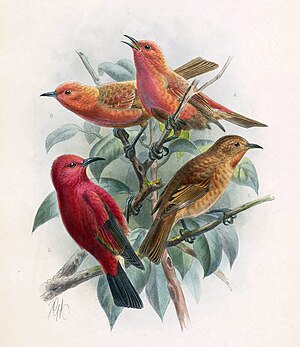Laysan Apapane
| Laysan Apapane | ||||||||||||
|---|---|---|---|---|---|---|---|---|---|---|---|---|

Laysan-Apapane, illustration by John Gerrard Keulemans |
||||||||||||
| Systematics | ||||||||||||
|
||||||||||||
| Scientific name | ||||||||||||
| Himatione fraithii | ||||||||||||
| Rothschild , 1892 |
The Laysan Apapane ( Himatione fraithii ) is an extinct songbird species from the group of honeysuckles (Drepanidini) in the finch family (Fringillidae). It was endemic to Laysan Island. The type epithet honors George Douglas Freeth Sr. , who became US governor of Laysan in 1892.
features
The Laysan Apapane reached a body length of 13 cm. The head, throat, chest, and upper abdomen were bright scarlet vermilion with a faint golden-orange tinge. The rest of the top was orange-scarlet. The lower abdomen was dark gray with a brownish-white tint. The under tail-coverts were greyish. Wings, tail, beak, legs and feet were dark brown. The iris was black with a brown outline. In the immature birds, the transitional dress was brown with a lighter underside. Their elytra had green feather trimmings. In comparison, the Apapane ( Himatione sanguinea ), which still occurs today on the Hawaiian Islands, is characterized by a generally blood-red plumage, by the black color of the wings and tail, by whiter under-tail-coverts and a longer beak.
Habitat and way of life
Habitat and way of life are primarily documented by the observations of the zoologist Walter Kenrick Fisher (1878–1953), who stayed on Laysan in 1902. Fisher wrote in 1903 that the birds could be found all over Laysan, but most often in the interior of the island between the tall grass and low scrub. The habitat was in the open plains near the lagoon, which apparently was the main gathering place for the land birds on Laysan.
The eggs and nest of the Laysan Apapane were first described by Hugo Schauinsland . He found a clutch of three white eggs with brownish-purple spots and chocolate-brown speckles and spots around the pointed pole. In 1899 he wrote:
"In two of the eggs, the largest longitudinal diameter was 20.5 mm, the transverse diameter 14.5 mm, and the third was 19.75 mm and 14 mm."
The eggs were laid from mid-May. A full clutch consisted of four to five eggs.
Nomenclature and systematics
The Laysan Apapane was discovered in 1828 during the Lütke circumnavigation of the world by the ship's doctor and naturalist Karl Izembek (also called Carl Isenbeck) on the island of Moller (= Laysan). Izembek called it a "little red bird" with black wings, which is not very common and which flew around the bushes. This form was described by Walter Rothschild in 1892 under the name Himatione fraithii based on specimens that Henry C. Palmer and George Campbell Munro had collected on Laysan in June 1891. Rothschild chose the epithet fraithii in recognition of George Douglas Freeth senior, who accompanied Palmer and Munro. Freeth was the manager of Max Schlemmer's guano mining operation, an amateur naturalist, and the governor of Laysan. In his work The Avifauna of Laysan (1893-1900) Rothschild used the spellings fraithi , fraithii and freethi . George Douglas Freeth was also mentioned here, which was not the case in the first description .
die out
From 1890 the guano deposits on Laysan were mined on a large scale. When the guano business was no longer profitable, Captain Max Schlemmer, a German industrialist and immigrant known as the "King of Laysan" decided to release rabbits on Laysan in 1904 in order to set up a rabbit meat market. However, this business was not profitable. The rabbits then reproduced so much that they ate almost all of the native vegetation on Laysan Island. After the rabbit plague was cleared up in 1923, the disastrous extent only became apparent. There were only a few trees left, but lots of sand. In 1911, the Laysan apapane population was estimated to be around 300 individuals. When members of the Tanager expedition, including Alexander Wetmore , were on the island in 1923 , only three specimens were counted. During this time ornithologist Donald Dickey managed to shoot the only film recording of a singing bird on a limestone hill. Soon after, a three-day sandstorm swept over Laysan, sealing the extinction of the Laysan apapane.
literature
- Steven G. Fancy, C. John Ralph: ' Apapane. In: Alan F. Poole , Frank Gill (Eds.): Birds of North America. Volume 296. Academy of Natural Sciences, 1997 (PDF, online)
- Harold Douglas Pratt : The Hawaiian Honeycreepers . Oxford University Press, 2005, ISBN 0-19-854653-X . P. 263
- Julian P. Hume , Michael P. Walters : Extinct Birds . 1st edition. T & AD Poyser, London 2012, ISBN 978-1-4081-5725-1 , Fringillidae, pp. 311-312.
Individual evidence
- ^ Walter K. Fisher: Notes on the Birds Peculiar to Laysan Island, Hawaiian Group The Auk. Vol. 20, No. 4 (Oct., 1903), pp. 384-397
- ^ Walter Kenrick Fisher: Birds of Laysan and the Leeward Islands, Hawaiian group. In: Bulletin of the United States Fiush Commission. Vol. XXIII for 1903. Part III. George M. Bowers. Commissioner. Washington: Government Printing Office, 1906. pp. 769-807.
- ^ Hugo Schauinsland: Three months on a coral island (Laysan). After a lecture given at the Geographical Association in Bremen. Nössler, Bremen, 1899, p. 66
- ^ Heinrich von Kittlitz: Message from the breeding places of some tropical sea birds in the calm ocean In: Museum Senckenbergianum: Treatises from the area of descriptive natural history, No. 1, 1834, p. 125.
- ↑ 1923 USS Tanager Expedition . In: Video . Northwestern Hawaiian Islands Mult-Agency Education Project.

